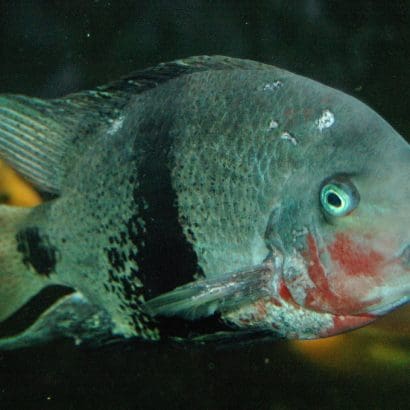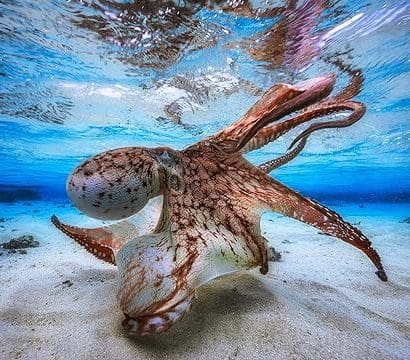
Diving into the underwater realm, where mystery and marvel intertwine, we encounter cephalopods – a remarkable group of marine wonders that have mastered the art of evolutionary innovation. From the deep-sea depths to coastal shallows, these creatures, including octopuses, squid, and cuttlefish, showcase unparalleled adaptability. In this exploration, we unravel the secrets behind the prowess of cephalopods, understanding how they have become the masters of change and innovation in the vast oceans they call home. Get ready to be amazed as we delve into the world of “Adaptation in Cephalopods: Masters of Evolutionary Innovation.
Contents
Camouflage and Mimicry.🐟
In the mysterious world beneath the waves, cephalopods unfold an extraordinary tale of survival through their mesmerizing camouflage and astonishing mimicry abilities. These underwater maestros, including octopuses, squid, and cuttlefish, have perfected the art of blending in with their surroundings, turning them into true masters of disguise.
Unveiling the Secrets of Camouflage:
Cephalopods, equipped with an ingenious toolkit for concealment, employ an enchanting feature called chromatophores. These are specialized cells in their skin that act like living pixels, allowing them to change color rapidly. Imagine an octopus smoothly transitioning from vibrant red to ocean blue in the blink of an eye, all thanks to these tiny, color-manipulating cells.
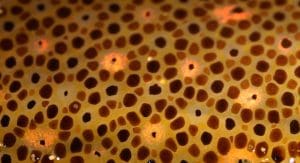
In the dance of adaptation, cephalopods use their chromatophores not only for self-expression but also as a strategic defense mechanism. Picture a cuttlefish seamlessly merging with the ocean floor, evading predators with its exquisite mimicry skills. The ocean becomes their canvas, and with each color change, they craft a masterpiece of invisibility.
The Mimicry Marvels:
Among the cephalopod stars, the mimic octopus takes center stage in the theater of mimicry. This incredible creature has earned its name by mimicking the appearance and behavior of various marine beings. It’s the ultimate method of trickery – a theatrical performance designed for both defense and hunting.
Consider a mimic octopus transforming into a venomous lionfish, deterring predators with the illusion of danger. Alternatively, it might mimic a toxic flatfish to sneak up on unsuspecting prey. This shape-shifting spectacle showcases the adaptability that has propelled cephalopods to the forefront of evolutionary innovation.
Adaptation in Action:
In the bustling underwater world, the intricate dance of Adaptation in Cephalopods unfolds as a survival strategy honed over millions of years. These beings, with their mesmerizing camouflage and mimicry, are not just avoiding danger but embracing it as a canvas for creativity. As we continue our journey into the depths, we witness nature’s artistic brilliance in the adaptive prowess of cephalopods – the true masters of evolutionary innovation.
While we dive into the depths of the ocean to unravel the secrets of “Adaptation in Cephalopods,” let’s not forget to bring some treasures to the surface. If you’re a culinary enthusiast seeking a delightful oceanic feast, check out our collection of 5 recipes with Abadejo fish. These delectable dishes not only showcase the diversity of marine flavors but also celebrate the wonders of the underwater world.
Biomechanical Adaptations.🐟
In the mesmerizing realm of the ocean, cephalopods unveil a spectacle of biomechanical marvels that propel them through the water with grace and precision. Let’s embark on a journey to explore the fascinating Biomechanical Adaptations of these underwater wonders, shedding light on their unique locomotion methods and the intricate workings of their nervous systems.
Unraveling Locomotion Secrets:
Cephalopods, from the elusive squid to the elusive octopus, harness a diverse array of locomotion techniques to navigate the ocean depths with unparalleled agility. Picture the mighty jet propulsion of a squid, propelling it through the water with powerful bursts of energy. Like underwater rockets, these creatures shoot through the waves, effortlessly evading predators and chasing prey.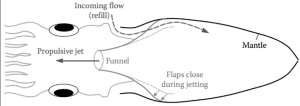
On the other hand, octopuses wield their flexible tentacles like skilled acrobats, employing a ballet of movements to maneuver through their watery domain. With each twist and turn, they demonstrate the artistry of adaptation, utilizing their tentacles not just for movement but also for grasping and exploration.
The Symphony of Nervous Systems:
At the heart of cephalopod locomotion lies a complex network of nerves and sensors, orchestrating every movement with precision and finesse. Their complex nervous systems act as the conductor of this underwater symphony, coordinating responses to environmental stimuli with remarkable efficiency.
As these cephalopods glide through the currents, their nervous systems come alive, processing sensory information and issuing commands with lightning speed. Whether it’s detecting the faintest vibrations of nearby prey or adjusting to changes in water temperature, their neural networks are finely tuned to the rhythms of the ocean.
Fishing as an Occupation:
In the world of marine biology, understanding the biomechanical adaptations of cephalopods isn’t just a matter of scientific curiosity—it’s also vital for those who depend on the sea for their livelihoods. For fishermen and marine researchers alike, unlocking the secrets of cephalopod locomotion opens new pathways for sustainable fishing practices and conservation efforts.
Cognitive Marvels.🐟
In the enchanting underwater realm, cephalopods not only captivate us with their mesmerizing appearance but also astound us with their remarkable cognitive abilities and problem-solving skills. Let’s dive into the depths of their intellect, exploring the mysteries of how these cephalopod prodigies navigate the challenges of their aquatic world.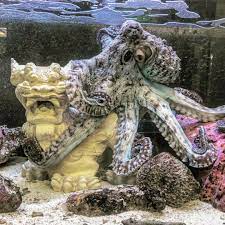
Unlocking the Puzzle-Solving Prowess:
Cephalopods, from the cunning octopus to the inquisitive squid, exhibit an intelligence that goes beyond the ocean’s surface. Numerous studies have shed light on their exceptional problem-solving skills, showcasing their ability to learn and navigate complex puzzles even in captivity.
Imagine an octopus inquisitively deciphering a puzzle box, each tentacle delicately manipulating the mechanisms until the solution emerges. These studies not only highlight the cognitive prowess of cephalopods but also emphasize their capacity for adaptability and learning, transcending the confines of their aquatic environments.
The Brilliance of Cephalopod Minds:
Central to the cognitive marvels of cephalopods are their large brains and distributed nervous systems. These intelligent beings boast a brain-to-body ratio that rivals some of the most sophisticated creatures on Earth. The significance lies not only in size but also in the intricacies of their neural networks, allowing them to process information rapidly and make decisions with astonishing speed.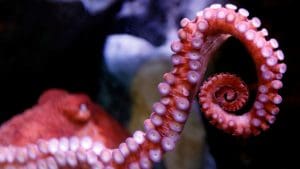
Their distributed nervous systems act as a decentralized powerhouse, facilitating quick responses to stimuli and enabling them to adapt swiftly to changing conditions. Picture a squid effortlessly outmaneuvering a predator or an octopus deftly navigating through a labyrinth of coral. It’s not just instinct; it’s the result of a highly developed cognitive toolkit honed through millions of years of evolution.
Adapting Minds in a Changing World:
As we marvel at the cognitive capacities of cephalopods, we recognize that their ability to learn, solve problems, and adapt isn’t just a survival strategy—it’s a testament to the incredible diversity of life in our oceans. These intelligent creatures, with their problem-solving prowess, are vital players in the delicate balance of marine ecosystems.
Habitat Adaptations: Thriving in Diverse Worlds.🐟
In the vast expanse of the ocean, cephalopods reveal an incredible tale of adaptation, where they conquer diverse habitats with ingenuity and resilience. Let’s embark on a journey to explore the remarkable Habitat Adaptations of these marine marvels, uncovering the secrets of their survival from the shallow coastal waters to the abyssal depths.
Adaptation Across Vast Oceans:
Cephalopods, from the elusive octopus to the graceful squid, have mastered the art of adaptation to thrive in a multitude of habitats. Through meticulous investigation, scientists have marveled at their ability to navigate the ever-changing landscapes of the ocean, from coral reefs to open waters and even the darkest depths.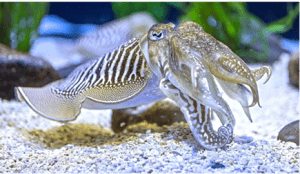
Picture a curious cuttlefish seamlessly blending into the colorful coral reefs, its chromatophores dancing in harmony with the vibrant marine life. Meanwhile, a cunning octopus ventures into the open ocean, its streamlined body slicing through the currents with effortless grace. These creatures exemplify adaptability, showcasing a remarkable ability to inhabit and explore diverse ecosystems.
Surviving the Depths:
In the mysterious world of the deep sea, cephalopods face extreme pressures and temperature variations that would challenge even the hardiest of creatures. Yet, through ingenious physiological adaptations, they have learned to withstand these harsh conditions and thrive in the abyssal plains.
Imagine a resilient squid descending into the dark abyss, its body equipped with specialized structures to counteract the crushing pressure of the depths. Its skin thickens, and its muscles strengthen, allowing it to navigate the icy currents with unwavering determination. These adaptations not only ensure survival but also enable cephalopods to exploit the bountiful resources hidden within the ocean’s depths.
Adapting for the Future:
As we unravel the mysteries of cephalopod habitat adaptations, we gain a deeper appreciation for the resilience of life in our oceans. These remarkable creatures not only survive but flourish in some of the most challenging environments on Earth.
Understanding their adaptations not only provides insights into the complexities of marine ecosystems but also highlights the urgent need to protect these fragile habitats. As stewards of the ocean, it is our responsibility to ensure that cephalopods and other marine life continue to thrive for generations to come.
Crucial Questions Answered.🐟
How do cephalopods camouflage themselves?
Los cefalópodos son maestros del camuflaje, y su habilidad para ocultarse asombra a científicos y entusiastas del océano por igual. Utilizan estructuras especiales en su piel llamadas cromatóforos. Estos diminutos pigmentos se combinan para crear una amplia gama de colores y patrones, permitiendo a los cefalópodos adaptar su apariencia a su entorno. Además, sus células reflectantes, iridóforos y leucóforos, contribuyen a crear ilusiones ópticas que los hacen prácticamente invisibles. Este camuflaje no solo les sirve como defensa contra depredadores sino también para acechar a sus presas de manera sigilosa.
What are some examples of mimicry in cephalopods?
El mundo de los cefalópodos es un escenario donde el arte del mimetismo alcanza su máxima expresión. El pulpo mimetizador es un ejemplo destacado. Este astuto maestro del disfraz puede imitar no solo el color y la textura de su entorno, sino también adoptar la apariencia y comportamiento de otras criaturas marinas. Desde transformarse en un peligroso pez león hasta simular ser una letal mantarraya, el pulpo mimetizador despliega su habilidad de manera impresionante para engañar tanto a presas como a depredadores.
How intelligent are cephalopods compared to other marine animals?
La inteligencia de los cefalópodos es una joya en el tesoro del reino marino. Se encuentran entre los animales más inteligentes del océano, y sus habilidades cognitivas rivalizan con algunas especies terrestres. Los pulpos, en particular, han demostrado capacidad de aprendizaje, memoria a largo plazo y habilidades para resolver problemas en cautiverio. Sus grandes cerebros y sistemas nerviosos distribuidos les permiten procesar información de manera rápida y adaptarse a cambios en su entorno. En comparación con otros animales marinos, los cefalópodos son verdaderos genios oceánicos, desafiando las percepciones tradicionales sobre la inteligencia en el mundo marino.

